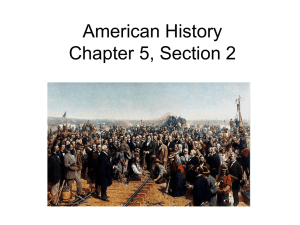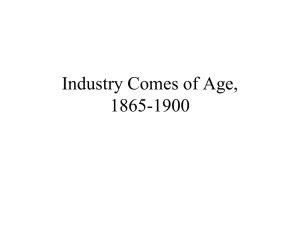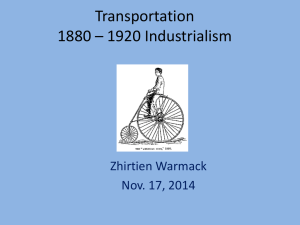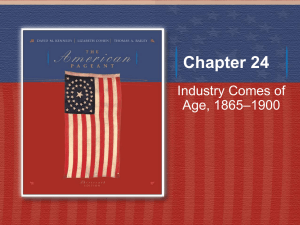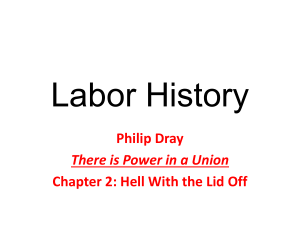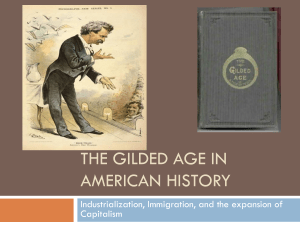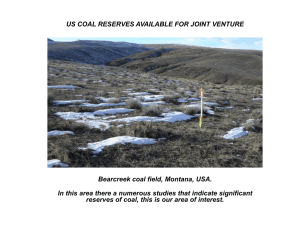Primary Sources and Games - Historical Society of Pennsylvania
advertisement
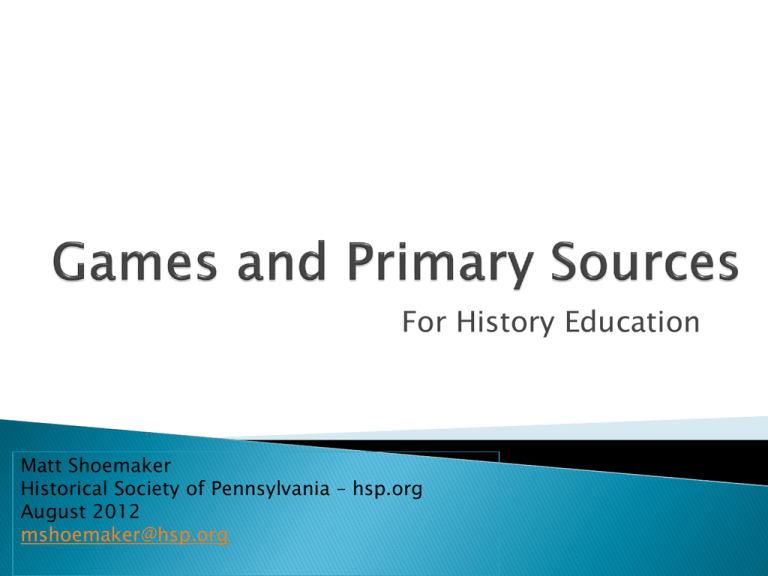
For History Education Matt Shoemaker Historical Society of Pennsylvania – hsp.org August 2012 mshoemaker@hsp.org History is created through humans reacting to the many systems around them ◦ Games provide a simulation of historical systems and add context of these systems to the lesson Games are interpretations that encourage questions Simulations are successful learning tools in other disciplines; why not the humanities? Board Games ◦ Have a lower barrier to access ◦ Easier to modify and expand ◦ Typically contain social components more suited to classroom use and for simulating direct human interactions Video Games ◦ Students may be more familiar with ◦ Can handle more complex mechanics “Core gameplay must offer defensible explanatory models of historic systems*” Students must be able to evaluate it on a historical level It should well model factors that influenced historical actors of the day *Gaming the Past, Jeremiah McCall Add context to the historical theme Increase insight on the view of a historical actor or group that players may utilize Provide focus for scenarios and game mechanics to enhance the simulation May provide more considerations for players’ interpretations and questions formed from gameplay Different levels of focus between games with abstract or direct historical connection 1. Identify the theme(s) on which you wish to focus for the lesson 2. Research available primary sources that meet the theme ◦ Local archives and archivists are there to help! 3. Knowing what sources are available can assist in identifying an appropriate game ◦ Games with an abstract historical connection are more flexible with the sources you can utilize and scenarios you can develop ◦ Games with a direct historical connection may require fewer sources and less modification as they essentially are scenarios, but these games also have less flexibility in the sources you can utilize with them NARA – National Archives Records Administration ◦ http://www.archives.gov/education/ State Archives ◦ Indiana State Archives - University Archives http://www.in.gov/icpr/2722.htm ◦ Ball State Archives and Special Collections - http://cms.bsu.edu/Academics/Libraries/CollectionsAndDept/Archives.aspx Historical Societies ◦ Indiana Historical Society - http://www.indianahistory.org/teachers-students/teacher-resources ◦ Local Historical Societies – ◦ http://www.in.gov/icpr/2932.htm Common core standards for history/social studies and English language arts Sample objectives: ◦ Student will be able to (SWBAT): Analyze the implications and effects of the Long Depression Describe the government's role in Analyze the cause/effects of Westward Expansion Evaluate the significance of Labor Unions Need time to learn the game ◦ Schedule class time if needed but can be done as homework ◦ Make the game available out of class hours if possible Educator can run students through a single game as a group or let students run it themselves Software, such as Vassal, exists that may work well with smartboards Have students create a scenario How would they represent events in primary sources through a simulation? How do historical events make them think about games? Can students improve the explanatory model of the game? Abstract historical connection ◦ The game’s thematic focus is on expansion of rail in America, but has no direct ties to specific dates, events, actors or groups Gameplay features trade, economics, network building, resource collecting and resource depletion Designed for 4 players, but works with teams Average 2 hour play time for vanilla game As a Catan game, it has mechanics similar to other games within the Catan family ◦ This helps provide proven mechanics to customizations by other players to similar games For example: The Settlers of Catan Complete Scenario and Variant Guide compiled by Kelvin Chung is a free 281 page guide of Catan scenarios and rules variants you can use for inspiration Rules additions should work independently of scenarios Determine if the selected game adequately simulates the themes you wish to emphasize and those represented within the sources. ◦ If not, can you implement a new mechanic or condition to simulate those themes? Try to add to the game rather than take away ◦ Do not change vanilla mechanics and conditions, other than victory conditions, if possible ◦ Removing established, vanilla mechanics and conditions risks unbalancing or breaking the game in unintended or undesirable ways Utilize primary source content to build context of scenario and tie to lesson Do not be afraid to vary player starting status, victory conditions, or in game effects if called for in the theme or lesson. Historical actors and groups were rarely equal across the board.* Scenarios allow you greater control of the gameplay ◦ Extend play ◦ Shorten play ◦ Alter players’ mission *See Scenario: Corporate Abuse Background – The year is 1870 and the railroad business has been booming since the end of the American Civil War. More people are employed in America by railroads than all other industries except Agriculture. The long depression, however, is brewing. The FrancoPrussian war begins this year, concluding in 1871. Following its victory, Germany decides to cease minting coins in silver. This ripples across the world affecting the price of silver and eventually is a major factor in the passage of the Coin Act of 1873, placing the United States effectively on a gold standard, further depressing the price of silver in the USA and causing instability to the United States monetary policy. Issues are compounded when that same year Jay Cooke & Company, a major banking institution, overextended itself in railroad securities and declared bankruptcy. This triggered the collapse of several other banks, the closing of factories, and the failure of dozens of railroads in what would be known as the panic of 1873. Scenario description: Players represent 4 of the more prosperous railroads of the day and are out to survive the long depression and come out of the event more profitable than the other players. The first three turns, representing 1870-1872, play out as a typical game of Settlers of America. Features: ◦ Fixed game length, 11 turns ◦ Possibility for players to be removed from game ◦ Set of 7 disaster events Deployed through either cards or dice ◦ Modified victory conditions Point total rather than all goods delivered Background: In the years 1871-1872, Franklin Gowen, the president of the Philadelphia and Reading Railroad, set up the Coal and Iron Company to begin a price fixing scheme of anthracite coal in the Pennsylvania and New York regions. First, he undercut the price of independent coal dealers to attract their clients to the Coal and Iron Company. Gowen then offered these dealers a consolidation, which they refused and he sought to drive them out of business. Following this step, and with controversy rising, Gowen created the first industry-wide price fixing in America by getting several other large coal executives to set prices and transportation load sizes. In 1875, Gowen found himself before an investigative committee to challenge the company’s practices and charter. Scenario Description: One player represents the Reading Railroad and begins the game at an advanced stage. The Reading Railroad has 3 turns to convince the investigative committee that their business practices are legal and not in violation of their charter. If they succeed, the game continues with the initial rules in place until victory conditions are met. If they do not succeed, detrimental effects for Reading Railroad take effect and the game continues until victory conditions are met. Features: ◦ Asymmetrical players ◦ Player influence on luck mechanics to determine other player’s fate ◦ Variable rules Background – It is early in America’s history with the railroad and already there is a call for a transcontinental corridor to boost trade, communications and accessibility of the United States. Numerous individuals have described their vision of how to achieve this task for the nation using public and private funds and ownership. How will the route of the railroad influence development of the country and the role of the United States on the world stage? Scenario description: Players represent 4 railroad companies looking to be a part of the transcontinental railroad. This scenario plays primarily as a regular game of Settlers of America except for the below changes to victory conditions and the role of goods delivery. Features: ◦ Victory points instead of goods delivery victory conditions ◦ Rules nearly identical to standard game Background – The industrial revolution brought about new ways to conduct business and provide products and services. This was no different for the railroad industry that required large amounts of workers to build its trains and rails, run and maintain its engines, service its customers and mine its coal. Labor disputes were inevitable as Americans and American businesses sought to try to balance working conditions, hours and pay with profits. As a result, the railroad industry saw several labor disputes, two of which involved the Philadelphia and Reading Railroad during 1877 while the Long Depression was in full swing. Scenario description: As executives of 19th century railroad companies players must try and strike a balance between their profits and labor satisfaction to win the game. Each player has their own labor satisfaction scale, from 1 to 10, which can trigger events and affect their profits and ability to win the game. It is also possible for a random economy event to take place at the beginning of a turn which may make a player more likely to change their previous stance with labor. Features: ◦ Economy event at start of turn ◦ Addition of labor phase ◦ Labor satisfaction scale influenced by a player’s business decisions Each player has their own scale that they are in control of ◦ Slightly modified victory conditions Railroad, Canal, Iron and Coal Map of Pennsylvania, 1869 ◦ ◦ Report of the President and Directors of the Northern Pacific Railroad Co. to the Stockholders, at the Annual Meeting, Sept. 25th, 1878 ◦ ◦ This map shows coal and iron deposits and the transportation networks within Pennsylvania. It gives a good sense of how natural resources and transportation networks are linked, and gives an idea of why certain cities were built where they were and why some of them may be in decline today. http://digitallibrary.hsp.org/index.php/Detail/Object/Show/object_id/573 In general, this document discusses the various branches of the railroad and how well they are doing. It also covers expenses and profits of the railroad. Pages 13-17 provide senate and house comments on the merits of the railroad as a public good and on granting, or not granting, public land and financial resources to private companies in order to build rail. http://digitallibrary.hsp.org/index.php/Detail/Object/Show/object_id/7857 Special report of a reconnoissance of the route for the Northern Pacific railroad between Lake Superior and Puget Sound, via the Columbia River: made in 1869 ◦ This source describes the journey taken by engineer W. Milnor Roberts to survey the route for the Northern Pacific Railroad. It describes what makes a good area for settlement and transportation, the attitudes of locals towards rail, and the costs of building a railroad among other things. http://digitallibrary.hsp.org/index.php/Detail/Object/Show/object_id/7858 A lecture on the railroad to the Pacific: delivered, August 12, 1850, at the Smithsonian Institute, Washington, at the request of numerous members of both houses of Congress ◦ ◦ Speech of Wm. Moseley Hall of Buffalo, N.Y. in support of his resolutions, which passed unanimously, in favor of a national r. road to the Pacific, on the plan of Geo. Wilkes : delivered at the Great River and Harbor Convention, at Chicago, Ill., in committee of the whole, July 7, 1847 ◦ ◦ Lecture detailing railroad as a means of cultural communication and takeover, particularly for Christian missionaries and a tool for evangelization. http://digitallibrary.hsp.org/index.php/Detail/Object/Show/object_id/7860 Argues that railroad is the western passage and death of the age of sail. Describes rail as a path to peace, a tool in nation building, sovereignty issues with native Americans and the benefits between public and private ownership of the rail road. http://digitallibrary.hsp.org/index.php/Detail/Object/Show/object_id/7861 Hazard's Rail Road and Military Map of the Southern States 1862 ◦ ◦ Map shows rail in the south and could provide good exercise for seeing if rail affected the growth of the cities it did, or did not visit in these areas. Also provides real world sample of routes that were constructed. Provides insight into possible rail use during the United States Civil War as well. http://digitallibrary.hsp.org/index.php/Detail/Object/Show/object_id/7921 Verbatim report of the general meeting of the share and bondholders of the Philadelphia and Reading Railroad Company held at the City of the Perkiomen Railroad Company held at the City Terminus Hotel, Cannon Street, London, June 6th, 1877: Thomas Wilde Powell, Esq.., in the chair. ◦ ◦ To the public [in respect to the conflict with the Brotherhood of Locomotive Engineers]: Philadelphia, April 24th, 1877 ◦ ◦ Themes of greed and anti-labor sentiment. Earnings reports, justification for bituminous coal land purchases, blame of poor performance on the long depression, troubles with labor. Also lists profits for some months. http://digitallibrary.hsp.org/index.php/Detail/Object/Show/object_id/7997 Lists the events and actions of the earlier labor strike in 1877 from the perspective of the Reading Railroad. http://digitallibrary.hsp.org/index.php/Detail/Object/Show/object_id/7998 Report of the Joint committee of the Legislature of Pennsylvania, appointed to inquire into the affairs of the Philadelphia and Reading coal and iron company and the Philadelphia and Reading railroad company, 1876 ◦ ◦ Comments on attempts to fix coal prices, the attempted formation of a coal oligopoly and the violation of charters granted to rail road companies. http://digitallibrary.hsp.org/index.php/Detail/Object/Show/object_id/7999 Western Pennsylvania Railroad lockout 1913 ◦ Photograph of workers on strike. ◦ http://digitallibrary.hsp.org/index.php/Detail/Object/Show/object_id/8033 Rail Road Memorial 1825 ◦ This document speaks to the changes that rail road has brought to civilization. The advantages of rail over canals, and the trade power struggle between Philadelphia and New York and how it is based on their ability to transport goods. ◦ http://digitallibrary.hsp.org/index.php/Detail/Object/Show/object_id/8034 The Battle of Seattle – A free game on the demonstrations against the 1999 World Trade Organization talks in Seattle, Brian Train, 2000. http://www.apolitical.info/seattle/ 1989: Dawn of Freedom – Jason Matthews and Ted Torgerson, GMT Games, 2012. Divided Republic: 1860 Presidential Campaign Game – Alex Bagosy, Numbskull Games, 2012. Founding Fathers – Players compete to be the planner remembered for creating the US Constitution. Christian Leonhard and Jason Matthews, Jolly Roger Games, 2012 (2nd edition). Hero of Weehawken: The Aaron Burr Conspiracy: 1805-1807 – Robert Leonhard, Victory Point Games, 2011. Ici, c’est la France!: The Algerian War of Independence 1954-62 – Kim Kanger, Legion Wargames, 2009. 1960: The Making of the President – Christian Leonhard and Jason Matthews, Z Man Games, 2007. Twilight Struggle: The Cold War, 1945-1989 – Ananda Gupta and Jason Matthews, GMT Games, 2005. Carcassonne – Tile game where players build the area around the medieval French city of Carcassonne, Klaus-Jürgen Wrede, Rio Grande Games, 2000. Catan Histories Series: “Settlers of America: Trails to Rails” (2010), “Struggle for Rome” (2006), “Settlers of the Stone Age” (2002) – Klaus Teuber, Mayfair Games. Diplomacy – Negotiation game where players are leaders of pre-WWI nations, Allan B. Calhamer, Avalon Hill, 1959 (Hasbro reprint 1999). Glory– First game by Fate of Civilizations, (in production) Puerto Rico – Players manage a plantation and develop San Juan, Andreas Seyfarth, Rio Grande Games, 2002. The Settlers of Catan – Klaus Teuber, Mayfair Games, 1995. Ticket to Ride – Players claim railway routes to earn points and dominate rail roads. Original game takes place in North America, later versions cover rail in other countries, Alan R. Moon, Days of Wonder, 2004. Fate of Civilizations – New resource/publisher by two history educators for using games in history education. www.fateofcivilizations.com Gaming the Past: Using Video Games to Teach Secondary History, Jeremiah McCall, Routledge Taylor and Francis Group, 2011. Gaming the Past.net: Historical Simulation Games in the Classroom, Jeremiah McCall, http://gamingthepast.net/ Journal of Digital Humanities, Special Section on Historical Gaming, Vol. 1, No. 2, Spring 2012. pp. 40-74. http://journalofdigitalhumanities.org/category/1-2/special-section/ PAXsims – (a blog devoted to the development and effective use of simulation-based learning), ed. Rex Brynen and Gary Milante. http://paxsims.wordpress.com/ Peasant Muse (a blog that regularly covers games and education, augmented reality and digital humanities), Jeremy Antley. http://www.peasantmuse.com/ Play the Past (a collaborative blog on cultural heritage, games and education). http://www.playthepast.org/ Augmented Reality Gaming and Game Design as a New Literacy Practice, James M. Mathews and Kurt D. Squire, Media Literacy: New Agendas in Communication, Routledge, 2009. pp. 209-232. Harnessing the Power of Games in Education, Kurt D. Squire and Henry Jenkins, Insight (3)1, pp. 5-33. http://website.education.wisc.edu/kdsquire/tenure-files/32-insight.pdf Productive Gaming: The Case for Historiographic Play, Kurt D. Squire and Shree Durga. To appear in R. Ferdig (Ed.) The handbook of educational gaming. Hershey, PA: Information Science Reference. http://website.education.wisc.edu/kdsquire/tenure-files/05-durgasquire-Final.pdf Replaying History: Learning World History Through Playing Civilization III, Kurt D. Squire, Dissertation Indiana University, 2004. http://website.education.wisc.edu/kdsquire/dissertation.html Revolutionizing History Education: Using Augmented Reality Games to Teach Histories, Karen L. Schrier, thesis at Massachusetts Institute of Technology, 2005. http://cms.mit.edu/research/theses/KarenSchrier2005.pdf ARIS – Open source mobile platform for augmented reality. Used in projects such as DOW day by UW-Madison for a tour game using primary sources. http://arisgames.org/ Kickstarter– Crowd funding website for creative projects. There are regularly projects with direct and abstract historic ties looking for funding. Divided Republic, for example, was a kickstarter project. Worth keeping an eye on for potential games. www.kickstarter.com Vassal - Vassal is a game engine for building and playing online adaptations of board games and card games. Play live on the Internet or by email. Vassal runs on all platforms, and is free, open-source software. http://www.vassalengine.org/ Historical Society of Pennsylvania www.hsp.org Matt Shoemaker Director of Digital Collections and Systems mshoemaker@hsp.org Thank you, Mayfair Games for providing copies of Settlers of America: Trails to Rails These slides and files are available at: http://hsp.org/primary-sources-and-games-for-history-education And http://slidesha.re/MXxZ36
